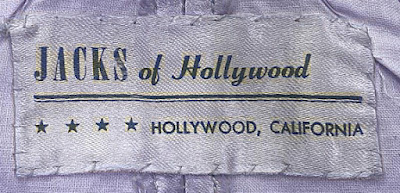While some sources claim Travilla started his post-Woodbury career at Western Costume, Travilla himself claimed that his first job was at Jack's of Hollywood, located at 1541 North Western Avenue, in 1939, with a starting weekly pay of $12. Jack's reputation was for creating the colorful and sequined costumes required by circuses, ice shows, and budget-conscious wardrobes for lower-end studios such as Republic and Monogram.
Travilla wrote in his unpublished memoirs that "Designers who could not draw well used to come in to rent a costume, and I'd sketch it for them. They'd ask me to alter the neckline or make some other minor changes, which I would. Then, they would sign their names to my sketches and show them to studio producers for approval." It certainly miffed the young artist, "however, it was good training for me as I could learn from my mistakes without taking credit for them."
He remembered the day Norwegian Olympic champion and 20th-century Fox star Sonja Henie came in to view the sketches for her upcoming fourth season of her Hollywood Ice Revue. Fox allowed Henie to tour the country, starring in elaborate productions that showcased her skating prowess. With the show so immense, including six production numbers, Sonja divided the costuming between several design houses. Jack's was given the prestige of her introduction number set under the sea, "Legend of the Pearl," and the ensemble numbers of "Reverie in White" and "Rhumboogie."
The drawings presented to her received a colder reception than those at her practice rink. Travilla recalled, "Sonja hated them. When you looked at the other designers' drawings, you didn't know what was going on. They were too vague. I watched her vent her disapproval by throwing them to the floor and even kicking a few."
Before Henie could storm out, the owner asked the skater to look at Travilla's ideas. In a stroke of genius, he illustrated them using Sonja's face, which resulted in the diva loving the designs and saving the day.
Travilla's concept was a white dress that was scooped-necked with short puffed sleeves. Sequins were scattered about the bodice and the short skirt. Atop her head was a tiara. Sonja's reveal was atop a pedestal, sitting in a tufted, clam-shaped seat. The ensemble wore tangerine and lime green sequinned, sprinkled satin, with the specialty skaters in shades of blues and violets. Atop their heads were hats made to resemble fish and other sea life.
At the end of the eight-day run in New York City, 135,000 attendees saw Travilla's creations. They also read his name in the show's 1940 program: "Miss Henie's Costumes designed by Billy Travilla Hollywood" (his first professional credit). Henie was so impressed with the young designer's work in October of 1941 that young Bill signed with A. & S Lyons, her agency, for representation. He joined an eclectic roster that included Eugene O'Neil, Cole Porter, Joan Crawford, Hedy Lamaar, and Ida Lupino. His agent was Wynn Rocamora, whose client list included Henie, Louella Parson, Maureen O'Sullivan, and Gloria Swanson.
He may have continued to design for Hennie over her next three seasons, though Kathryn Kuhn did many of Sonja's pieces. Henie tapped him to create the costumes for the Persian and Slavic-themed numbers in her 1944's "Hats Off to Ice", which was her most popular show. The show premiered in New York City, where Travilla received his first mention in Women's Wear Daily's June 27 review.
Women's Wear Daily mentioned in February 1962 that Henie was at Travilla's salon being fitted for the white beaded evening gown she'd wear on her upcoming trip to London. Part of her vast art collection was on exhibition at the Tate Gallery. Sonja received a telegram at his salon informing her that Princess Margaret and the Earl of Snowden would attend. Photographs show her happily greeting the royal couple and proudly showing them around the gallery.
Travilla's paternal grandfather, William Snyder, died in early February 1941, leaving the young man $5000. Travilla wrote how he entrepreneurially invested a portion in creating a company that, in theory, "met the needs for quality designs by working with other studio contract designers." However, the greenbacks didn't flow as much as the green monster reared its ugly head. "There seemed to be jealousy among all these so-called designers. I was viewed as a last resort in case I would copy their creations."
Taking a break from the drama, on May 16, he departed for the Tahatti aboard the Lurlene with his grandmother Estelle and aunts Ethel and Lucille. After arriving in Honolulu, the group proceeded to Pago Pago for two weeks before returning home to San Pedro on June 17. The memories and experiences in these weeks would serve the designer well for the rest of his career. (Later in life, Travilla would claim he spent an entire year traveling about the South Seas on his inheritance.) Shortly after returning, Billy's draft number, #s84, came up on July 17, 1941, but he avoided the draft due to flat feet.
He returned to design costumes for two Hal Roach Studio productions. First was the Latin-themed Technicolor musical Fiesta. While a "modern" picture, it was set in a Mexican village so the costumes were colorfully "authentic."
Next was the college comedy All-American Co-ed. While he is credited for Costumes, Irene Saltern is credited for the gowns. Saltern was also adept at creating current fashion trends and possibly created other pieces.
Some outfits were pulled from inventory as Martha Tanner, one-third of a sister singing group, wears a costume Carole Landis wore in Topper Returns, released ten months earlier.
Travilla's specialty might have been the outlandish garb for both men in chorus girl drag and then a farm-themed production number, including "Corn Queen," "Grape Queen," "Tomato Queen," "Celery Queen," and "Pepper Queen.".



































No comments:
Post a Comment